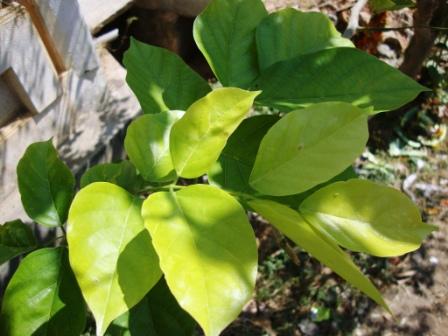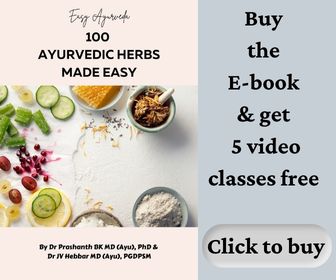Karanja – Pongamia pinnata: Uses, Side Effects, Research
Karanja is an important Ayurvedic medicine, used predominantly in skin diseases. Karanja twigs were used as toothbrush in ancient times.
Its botanical name is Pongamia pinnata.
Synonym: Millettia pinnata, Pongamia glabra.
It belongs to the Fabaceae family. (Shimbi Kula)

Table of Contents
Medicinal qualities
Rasa (taste) – Tikta – Bitter, Katu (pungent), Kashaya (astringent)
Vipaka – taste conversion after digestion – Katu (pungent)
Veerya – Hot potency
Guna (qualities) – Laghu (light to digest), Teekshna (piercing)
Effect on Tridosha – Balances kapha and Vata
Pharmacological action – Anti bacterial, hypoglycaemic, anti pyretic, Wound healing
Varieties
Bh. Pr. Ni 3 types
Ghrita kaanja
Kantakari karanja
Karanji
Ra. Ni – 6 types
Karanja
Ghrita karanja
Mahakaranja
Putikarana
uccha karanja
Rita karanja
Traditional uses of Karanj
In ayurvedic classical literature also the seed and seed oil is appreciated in different contexts in the treatment of varieties of neuro- muscular disorders and in skin diseases. The barks as well as leaves are also quoted for the treatment of blood borne diseases as well as to take out the excess morbidity from the body. It is the reason why it is used in several chronic disorders, especially in vatic disorders and in hemorrhoids, fistula and sinus conditions. The wound healing ability of the bark was appreciated hundreds of years back itself.
In recent days bitter principles of this plant have created a lot of hope in giving significant benefit in Type II Diabetes Mellitus cases too.
Yonidoshahrut – detoxifies vaginal diseases, useful in uterine disorders.
Kushtaghna – useful in skin diseases
Udavartahara – relieves bloating
Gulmahara – relieves abdominal tumour, bloating
Arshahara – Useful in piles / haemorrhoids
Vranahara – helps in quick wound healing
Krumihara – relieves worm infestation
Pongamia pinnata leaves are –
Kaphavatahara – balances Kapha and Vata
Arshahara – Useful in piles / hemorrhoids
Krumihara – relieves worm infestation
Shothahara – relieves inflammation
Bhedana – induces diarrhoea, relieves constipation
Pittala – increases Pitta
Pongamia pinnata fruits –
Kaphavataghna – balances Kapha and Vata
Mehahara – useful in urinary tract disorders and diabetes
Arshahara – Useful in piles / hemorrhoids
Krumihara – relieves worm infestation
Kushtajit – useful in skin diseases, psoriasis.
Miscellaneous uses of Karanja:
In case of skin diseases where the skin lesions are numb and absolutely anesthetic, if there is absence of sweating and itching, then they are rubbed with the brush made of the stem of Karanj so as to initiate bleeding. This is described as a method of bloodletting therapy to treat skin diseases. Reference: Charaka Chikitsa Sthana 7/56
Home Remedies of Pongamia Pinnata
Home Remedies
By Dr MS Krishnamurthy MD(Ayu), PhD
In traditional practice as well as in folklore practice Karanja is used in different cases and conditions and few important ones are explained here below-
Wound Care
1. Karanja bark decoction to wash the wounds:
20-30 grams of stem bark of Karanja is taken and crushed well. This is boiled with water and reduced to ¼. This decoction is used to wash the chronic ulcers and wounds. For sitz baths also this is used, especially after anorectal surgeries and kshara therapies.
Read related:
Wasp Bite
2. Fresh juice of the leaf in insect and wasp bite :
The fresh leaf juice of the plant is applied over the lesions of wasp bite or insect bite. This reduces the swelling and pain instantly.
Eczema
3. Turmeric and pongamia seed paste in eczema:
Equal amounts of fresh rhizomes of turmeric and pongamia seeds are taken and fine paste is made.
This is applied over the skin lesions like eczema, scabies etc and good results are observed.
Conjunctivitis
4. Pongamia young leaf shoots decoction in conjunctivitis:
The young shoots of the leaves are taken and decoction is made or else soaked in water and macerated to obtain cold infusion. This is used to instill in the eyes or to wash the eyes. This relieves pain, discoloration and gritty feeling caused during the conjunctivitis.
Hemorrhoids
Pongamia dry bark powder and Triphala coarse powder are taken in 1:1 ratio and decoction is made. This decoction is used to administer internally (in the dose of 20-30 ml) and externally, for sitz bath in case of post operative care of ano-rectal alkaline therapies (Kshara therapy).
Karanja plant is an evergreen plant that adds beauty to nature. It is the reason why it is planted on both sides of the roads. Also due to its dense leaflets and wide spread branches it is giving considerable shade to the walking tracks. The flowering of the plant also makes nature beautiful and the huge medicinal values made it so appreciable among the people.
Parts used
KaranjaParts used – fruit, leaves, root bark, stem bark, seeds, twigs, seed oil.
Karanja oil is widely used in the treatment of skin diseases.
Its oil is also tested for use as bio-diesel.
Which part of this plant is antiviral for oral uses?
Seed extract, leaves, root bark and stem bark have anti viral properties and are edible.
Pongamia oil
It is a source of bio-diesel and is used in Ayurveda for external application to shrink pile mass, to heal wounds and abscesses quickly.
It is useful in acne vulgaris, pimples with secretions.
Sanskrit name – Karanja taila
Kannada name – Honge enne.
Telugu name – Kanuga oil
Hindi name – Karanj tel
Tamil name – Pungai oil, Pungai ennai (oil), Pungai kai (fruit)
Pongamia oil is extracted from seeds by expeller pressing, cold pressing, or by means of solvent extraction.
It contains below fatty acids –
Palmitic acid – 3.7% – 7.9%
Stearic – 2.4% – 8.9%
Oleic acid – 44.5% – 71.3%
Linoleic acid – 10.8% – 18.3%
Linolenic acid – 2.6%
Arachidic acid – 2.2% – 4.7%
Eicosenoic acid – 9.5% – 12.4%
Behenic acid – 4.2% – 5.3%
Lignoceric – 1.1% – 3.5%
Interaction with medicines, supplements
Can this be used while taking Homeopathic medicine?
Yes. This product does not react with homeopathic medicine.
Can this medicine be continued while taking supplements like multivitamin tablets, Omega 3 fatty acids etc?
Yes. Generally, this product goes well with most dietary supplements. However, if you are taking more than one product per day, please consult your doctor for an opinion.
With western
medicines
Seek your
doctor’s advice if you are taking this product along with other western
(allopathic / modern) medicines. Some Ayurvedic herbs can interact with modern
medicine.
If both Ayurvedic and allopathic medicines are advised together, then it is
best to take Allopathic medicine first, wait for 30 minutes and then take the
Ayurvedic medicine.
Ayurvedic medicines
Ayurvedic medicines with Karanja as ingredient:
Karanja Taila – used in herpes, boils, abscess, pigmentation and eczema
Murivenna – Used for quick wound healing and to relieve pain and inflammation.
Vilwadi Gulika – used in scorpion bite, fever, toxic and psychological conditions.
Maha Manjishtadi Kashayam – Used in gout, syphilis etc.
Somaraji Tailam – Used in eczema, psoriasis etc.
Proprietary Ayurvedic medicines with Pongamia oil as ingredient:
De Pile Ointment – used for the treatment of external and internal hemorrhoids.
Dermasyl Skin Ointment – manufactured by Tulsi Pharmaceuticals. It is an anti-infective skin preparation used in the treatment of eczema, scabies etc.
Dermafex oil – used for the treatment of eczema and psoriasis, manufactured by BAN Labs Ltd.
Dermafex soap
Habitat
Pongamia pinnata in India
Karanja trees are distributed throughout India up to 1200 feet height from sea level.
Pongamia pinnata (L. ) Pierre is popularly known as Karanja, Indian beech, Pongamia tree, Indian pongamia. The plant Karanja is widespread in India, Japan, Australia, Malaysia etc.
Vernacular names, Sanskrit synonyms
Hindi name – Dithouri
English name – Indian beech
Malayalam, Tamil name – Pongum
Kannada name – Honge mara
Sanskrit Synonyms:
Karanja – which colours water
Naktamala – looks good at night
Udakirya – Flowers are seen scattered on water during winter
Gucchapushpaka – flowers appear in bundles
Ghritapoora – seeds yield thick oil which looks similar to ghee.
Snigdhapatra – leaves are shining, oily.
Morphology
Medium sized tree
Leaves – compound, Elliptic leaves
Inflorescence – Tree Axillary raceme
Flowers – Papilionaceous, petals are sub orbicular with curved folds above the claw.
Fruits – Pods
Seeds – Reniform shaped single seed
Chemical composition
The seeds contain 27% bitter and dark colored fixed oil popularly known as Pongamia oil.
Bark contains bitter alkaloid, resin, mucilage and sugar. The important chemical constituents are karanjin, ovalitenone, kanugin, pongapin, 3-metho-oxypongapin, pongaglabrone, kanjone, pongol, gamatin, ionchocarpin, isochocarpin, glabrin, neoglabrin etc.
It is one of the widely available and cultivated trees. The seed contains 33–36% oil, 20–28% protein and it is characterized by the presence of minor constituents such as flavonoids.
Scientists have identified its anti-ulcerative property due to karanjin, isolated from karanja seeds.
The karanja seed oil contains a good amount of omega 9 fatty acids that quickly absorbs through the skin, making it a noteworthy remedy for dry skin.
Classical categorization
Charaka Samhita – kandughna – group of herbs that relieve itching
Katuka Skandha – pungent tasting group of herbs.
Charaka has mentioned it as a plant source for oil – Sthavara Sneha Yoni (Reference)
Sushruta Samhita – Aragvadhadi, Varunadi, Arkadi, Shyamadi group of herbs, Kaphasamshamana (herbs that balance Kapha).
Dosage
Seed powder – 1 -3 g
Seed oil – 3 ml
Leaf juice – 10 – 20 ml
Sthanika Karma (Systemic Action)
External Application – its bark has Antimicrobial, Anti Antipruritics, Anti inflammatory properties. Seed oil promotes wound healing. indicated in various skin disorders. In vata related disorders its leaves are made too hot and can be tied. Leaf paste is also indicated in wound swelling. Powder can be used as Nasya in sirorogas
Internal administration-
Digestive System – Bitter and spicy in taste, Carminative, digestive, Anti microbial, liver stimulant. and helps to eliminate morbid doshas from the body. Its bark and leaf juice indicated in loss of appetite, constipation, Udavarta, phantom tumor, helminthiasis, hemorrhoids etc. Seed oil especially has Antimicrobial action.Circulatory System – It helps for blood purification.. Its hot potency helps to reduce oedema. Indicated in Amavata.
Excretory System – Reduce urine quantity. Indicated in Diabetes. Its flowers are indicated in Ikshumeha.
Respiratory System – Pacify Kapha dosha, Seed powder is indicated in Cough(Kukkura kasa).
Reproductive system – Helps to eliminate morbid doshas from uterus (Garbhayasaya sodhaka)
Tvak (Skin) – Indicated in skin diseases









19 comments on “Karanja – Pongamia pinnata: Uses, Side Effects, Research”
Prof. Dr. N. Satya Prasad. M.D.,PGDHM, Hyderabad.
Good and detailed information. Thanks.
UDAYAKUMAR KOLLIMATH
It is an amazing plant. Thanks to Forestry Department for planting more number of Pongamia trees in the state of Karnataka. I am also told the leaves have antimicrobial properties and good for tooth related problems.
Arun
Hi, just want to ask what if karanja is having any Khara Guna
Dr J V Hebbar MD(Ayu)
It would still possess all the qualities that are mentioned in the article above.
Dr J V Hebbar MD(Ayu)
I am not aware of any source. I hope that someone would help you.
mir
is it antimirobial..?
Jay
How to use it for seborrhoeic dermatitis? And is it effective on it?
Pramila
Is it used to get rid of pigmentation
N K Gupta
Whether the dry flowers of Mongolia pinnata have any anti allergic effect
Ramesh kothari
Sir, is it beneficial for diabetes,how to use
pinju
Sir can you please add an ayurvedic Sloga reference Of this plant???
Dr J V Hebbar MD(Ayu)
Will do so in future.
Jagannath Pr Raju
From my childhood I was aware of this Karanja, which is used as toothbrush. But now I am happy to know about these type of benefits. Thanks for the knowledge you shared Dr. Hebbar
Please do update if any other info like is it helpful for hair regrowth or not???
Jeslin
Is leaf edible?
Dr J V Hebbar MD(Ayu)
No.
S Padma Jyothi
Namaste Doctor. Can this oil be applied for Cellulytis
Dr J V Hebbar MD(Ayu)
Namaste. Yes.
Theresa Mukherjee
Can these leaves be taken when I taking drugs for cancer treatment
Dr J V Hebbar MD(Ayu)
Yes, if advised by your Ayurvedic doctor.